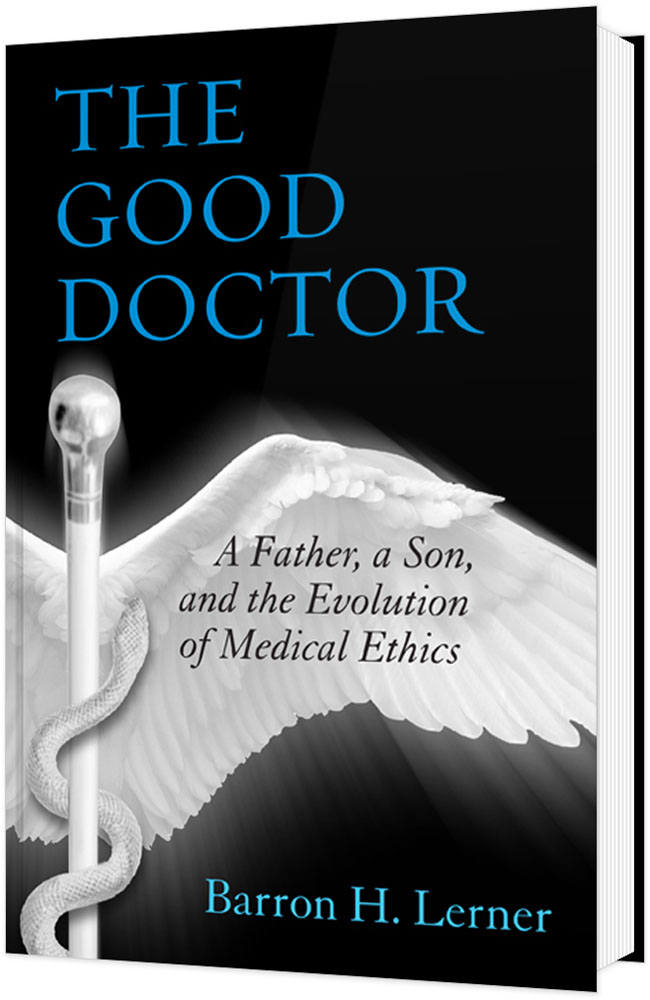The Good Doctor
A Father, a Son, and the Evolution of Medical Ethics
Publication Date: May 13, 2014
The story of two doctors, a father and son, who practiced in very different times and the evolution of the ethics that profoundly influence health care
As a practicing physician and longtime member of his hospital’s ethics committee, Dr. Barron Lerner thought he had heard it all. But in the mid-1990s, his father, an infectious diseases physician, told him a stunning story: he had physically placed his body over an end-stage patient who had stopped breathing, preventing his colleagues from performing cardiopulmonary resuscitation, even though CPR was the ethically and legally accepted thing to do. Over the next few years, the senior Dr. Lerner tried to speed the deaths of his seriously ill mother and mother-in-law to spare them further suffering.
These stories angered and alarmed the younger Dr. Lerner—an internist, historian of medicine and bioethicist—who had rejected physician-based paternalism in favor of informed consent and patient autonomy. The Good Doctor is a fascinating and moving account of how Dr. Lerner came to terms with two very different images of his father: a revered clinician, teacher and researcher who always put his patients first, but also a physician willing to “play God,” opposing the very revolution in patients’ rights that his son was studying and teaching to his own medical students.
But the elder Dr. Lerner’s journals, which he had kept for decades, showed his son how his outdated paternalism had grown out of a fierce devotion to patient-centered medicine that was rapidly disappearing in a world of managed care, spiraling costs and health care reform. And they raised questions: Are paternalistic doctors just relics or should their expertise be used to overrule patients and families that make ill-advised choices? Does the growing use of personalized medicine—in which specific interventions may be best for specific patients—change the calculus between autonomy and paternalism? And how can we best use technologies that were invented to save lives but now too often prolong death? In an era of high-technology medicine, spiraling costs and healthcare reform, these questions could not be more relevant.
As his father slowly died of Parkinson’s disease, Dr. Lerner faced these questions both personally and professionally. He found himself being pulled into his dad’s medical care, even though he had criticized his father for making medical decisions for his relatives. Did playing God—at least in some situations—actually make sense? Did doctors sometimes “know best?”
A timely and compelling story of one family’s engagement with medicine over the last half century, The Good Doctor is an important book for those who treat illness—and those who struggle to overcome it.
Articles on medical ethics by Dr. Lerner.
One for the Road
Drunk Driving since 1900
Publication Date: September 7, 2011
Don’t drink and drive. It’s a deceptively simple rule, but one that is all too often ignored. And while efforts to eliminate drunk driving have been around as long as automobiles, every movement to keep drunks from driving has hit some alarming bumps in the road.
Barron H. Lerner narrates the two strong—and vocal—sides to this debate in the United States: those who argue vehemently against drunk driving, and those who believe the problem is exaggerated and overregulated. A public health professor and historian of medicine, Lerner asks why these opposing views exist, examining drunk driving in the context of American beliefs about alcoholism, driving, individualism, and civil liberties.
Angry and bereaved activist leaders and advocacy groups like Mothers Against Drunk Driving campaign passionately for education and legislation, but even as people continue to be killed, many Americans remain unwilling to take stronger steps to address the problem. Lerner attributes this attitude to Americans’ love of drinking and love of driving, an inadequate public transportation system, the strength of the alcohol lobby, and the enduring backlash against Prohibition. The stories of people killed and maimed by drunk drivers are heartrending, and the country’s routine rejection of reasonable strategies for ending drunk driving is frustratingly inexplicable.
This book is a fascinating study of the culture of drunk driving, grassroots and professional efforts to stop it, and a public that has consistently challenged and tested the limits of individual freedom. Why, despite decades and decades of warnings, do people still choose to drive while intoxicated? One for the Road provides crucial historical lessons for understanding the old epidemic of drunk driving and the new epidemic of distracted driving.
Articles on drunk driving by Dr. Lerner.
When Illness Goes Public
Celebrity Patients and How We Look at Medicine
Publication Date: October 20, 2006
When Illness Goes Public: Celebrity Patients and How We Look at Medicine
Publication Date: November 20, 2006
Steve McQueen had cancer and was keeping it secret. Then the media found out, and soon all of America knew. McQueen’s high profile changed forever the way the public perceived a dreaded disease.
In When Illness Goes Public, Barron H. Lerner describes the evolution of celebrities’ illnesses from private matters to stories of great public interest. Famous people who have become symbols of illness include Lou Gehrig, the first “celebrity patient”; Rita Hayworth, whose Alzheimer disease went undiagnosed for years; and Arthur Ashe, who courageously went public with his AIDS diagnosis before the media could reveal his secret. And then there are private citizens like Barney Clark, the first recipient of a permanent artificial heart, and Lorenzo Odone, whose neurological disorder became the subject of a Hollywood film.
While celebrity illnesses have helped to inform patients about treatment options, ethical controversies, and scientific proof, the stories surrounding these illnesses have also assumed mythical characteristics that may be misleading. Marrying great storytelling to an exploration of the intersection of science, journalism, fame, and legend, this book is a groundbreaking contribution to our understanding of health and illness.
Articles by Dr. Lerner.
The Breast Cancer Wars
Hope, Fear, and the Pursuit of a Cure in Twentieth-Century America
Publication Date: May 1, 2003
In this riveting narrative, Barron H. Lerner offers a superb medical and cultural history of our century-long battle with breast cancer. Revisiting the past, Lerner argues, can illuminate and clarify the dilemmas confronted by women with–and at risk for–the disease. Writing with insight and compassion, Lerner tells a compelling story of influential surgeons, anxious patients and committed activists. There are colorful portraits of the leading figures, ranging from the acerbic Dr. William Halsted, who pioneered the disfiguring radical mastectomy at the turn of the century to Rose Kushner, a brash journalist who relentlessly educated American women about breast cancer.
Lerner offers a fascinating account of the breast cancer wars: the insistent efforts of physicians to vanquish the “enemy”; the fights waged by feminists to combat a paternalistic legacy that silenced patients; and the struggles of statisticians and researchers to generate definitive data in the face of the great risks and uncertainties raised by the disease. And for this new paperback edition, Lerner has included a postscript in which he discusses the most recent breast cancer controversy: do mammograms truly lower mortality rates or do they lead to unnecessary mastectomies?
In Lerner’s hands, the fight against breast cancer opens a window on American medical practice over the last century: the pursuit of dramatic cures with sophisticated technologies, the ethical and legal challenges raised by informed consent, and the limited ability of scientific knowledge to provide quick solutions for serious illnesses. The Breast Cancer Wars tells a story that is of vital importance to modern breast cancer patients, their families and the clinicians who strive to treat and prevent this dreaded disease.
Articles on cancer by Dr. Lerner.
Contagion and Confinement
Controlling Tuberculosis along the Skid Road
Publication Date: November 16, 1998
Most historians of tuberculosis have focused on the sanatorium era of the early twentieth century, losing interest in the disease with the discovery of curative antibiotics in the 1940s. In Contagion and Confinement, Barron H. Lerner offers the first in-depth look at the history of tuberculosis control in the antibiotic era, providing a vital account of this neglected chapter in the history of the disease. He argues that the new antibiotic drugs, rather than being a simple panacea, actually highlighted the complex social problems that continued to predispose people to tuberculosis and interfere with its treatment.
The most controversial strategy used by American health officers to control tuberculosis was forcible detention. Since 1903, Lerner notes, health departments have locked up tuberculosis patients whose behavior presented a public health threat. Using Seattle’s Firland Sanatorium as a case study, he focuses on the surprisingly recent use of detention between 1950 and 1970. Although Firland planned to use confinement only as a last resort, Lerner explains, the facility detained nearly 2,000 patients, most of them alcoholics from Seattle’s famous “Skid Road.” In retrospect, it is clear that Firland staff members overused detention. But Lerner also finds that they worked hard to improve the lives of the alcoholic patients society had forgotten.
Given the resurgence of tuberculosis and the renewed use of detention in the 1990s, Contagion and Confinement raises issues that are both timely and controversial. Although modern public health officials are duly concerned with civil liberties, they still have great authority to detain tuberculosis patients who do not take their antibiotics. Recent studies show that such persons are most likely to be homeless, HIV-positive, or drug users. Society is still struggling, Lerner concludes, to balance public health concerns with respect for patients.
Articles by Dr. Lerner.




